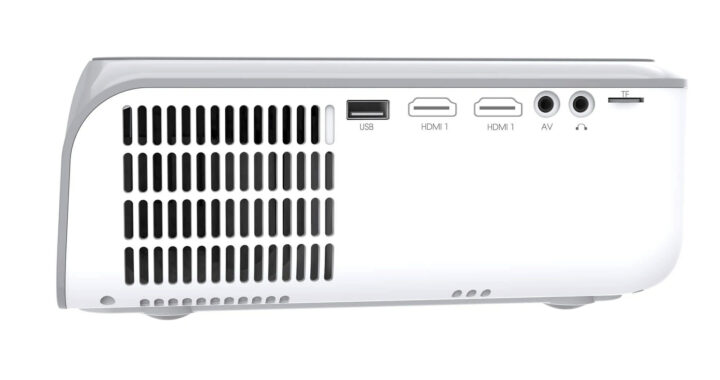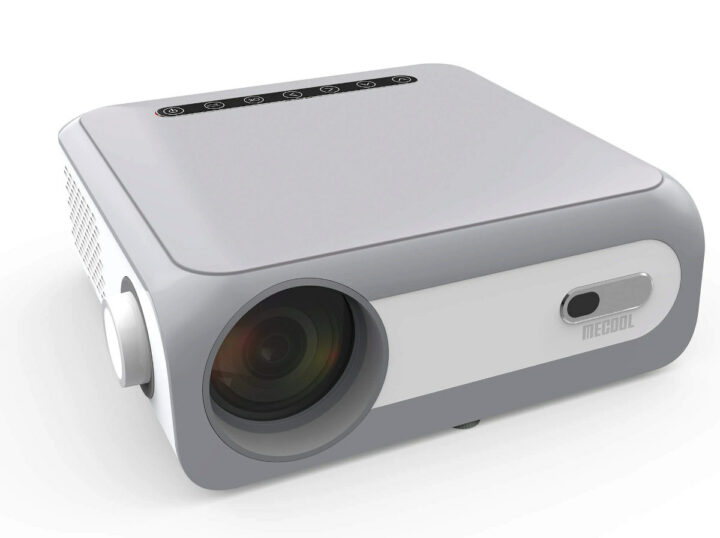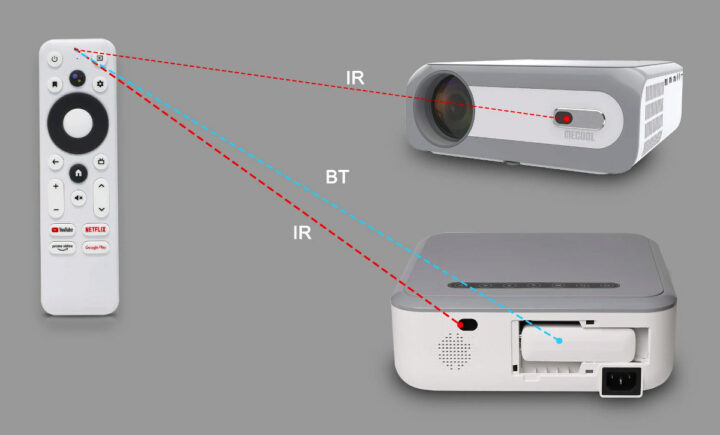MECOOL KP1 is a Full HD projector equipped with the MECOOL KD5 HDMI dongle powered by an Amlogic S805X2 quad-core Cortex-A35 processor with 1GB RAM and 8GB flash and running Android 11 for TV.
Most Android projectors are equipped with a low-end processor accompanied by an outdated version of Android, and while the Amlogic S805X2 SoC found in the KP1 is not a workhorse, Android 11 for TV OS should make it useable for a few more years, and it might even be possible to upgrade the TV stick down the road.
MECOOL KP1 specfications:
- TV Stick – MECOOL KD5 with
- SoC – Amlogic S805X2 quad-core Arm Cortex-A35 processor with Arm Mali-G31 MP2 GPU, 1080p60 10-bit AV1, H.265, VP9 P-2, H.264, AVS2, MPEG4/2/1 video decoder
- System Memory – 1GB LPDDR4
- Storage – 8GB eMMC flash
- Video Output – HDMI 1.4 port
- Connectivity – Dual-band WiFi 5 and Bluetooth 4.2
- OS – Android TV on Android 11
- LCD Projector
- Native Resolution – 1920×1080
- Luminance – 700 ANSI Lumens
- Light Source Brightness – 14000~15000lux
- Contrast Ratio – 10000:1
- LED Life – > 30,000 hours
- Projection Parameters
- Throw Ratio – 1.3
- Focus Mode – Manual Focus
- Keystone Correction – Vertical (Auto ±50°), Horizontal (±50°), Rotation (±50°)
- Projection Mode – Front/Rear/Front Ceiling/Rear Ceiling
- Projection Size – 45-inch to 240-inch
- Storage – MicroSD card slot
- Video Inputs
- 3x HDMI inputs, including one used by MECOOL KD5
- AV port
- Audio
- 3.5mm audio jack for speakers or headphones
- 5W speaker
- Misc – 2x IR receivers, buttons at the top for power, volume, menu control, etc…
- Power Supply – AC100~240V
- Dimensions – 234 x 211 x 87.5mm
- Weight – 2.3kg
The MECOOL KP1 projector ships with a MECOOL KD5 TV stick and its IR & Bluetooth remote control, HDMI and AV cables, a power cable, and a quick start guide. You can see the TV stick at the bottom right of the photo above, as it’s handling Bluetooth connectivity from the remote control, while the projector comes with two IR receivers one at the front and the other at the back.
The MECOOL KD5 TV stick is Netflix and Google certified, so you’ll benefit from that with the projector too, and while the processor is not that powerful it still supports 1080p60 AV1 video decoding and HDR10+.
 I’m still using Rikomagic RKM R1 mini Projector (RK3128 + Android 4.4) from time to time, mostly for the projector function, and I should get a MECOOL KP1 sample, so it would be an interesting comparison.
I’m still using Rikomagic RKM R1 mini Projector (RK3128 + Android 4.4) from time to time, mostly for the projector function, and I should get a MECOOL KP1 sample, so it would be an interesting comparison.
MECOOL KP1 projector is sold for $349 on MECOOL website, and shipping should start in about 5 days.

Jean-Luc started CNX Software in 2010 as a part-time endeavor, before quitting his job as a software engineering manager, and starting to write daily news, and reviews full time later in 2011.
Support CNX Software! Donate via cryptocurrencies, become a Patron on Patreon, or purchase goods on Amazon or Aliexpress. We also use affiliate links in articles to earn commissions if you make a purchase after clicking on those links.







Chigz on YouTube did a MECOOL KD5 TV Stick Review, he said it is OK for streaming and the memory limited for anything more.
Good how the stick might allow you future update the Projector.
I dont understand, this is a projector + a sbc ? why ?
There are some smart projectors running Android. That one is similar except there’s a TV stick inserted in one of the HDMI input ports. The advantage is that it could be easily upgraded, and it should offer better integration than using a projector plus an Android TV box or TV stick since you can use a single remote control to control both.
You have the S805X2 described as Cortex-A35 and A53 in the article.
Oops. It’s Cortex-A35. I blame Arm for that 🙂
ZTE’s just announced a new HDMI TV stick – B866V5W11 – with USB-C power port but apart from stating that it’s quad core Amlogic Cortex-A35 based, they don’t actually state which CPU specifically is used, nor whether it has eMMC, μSD, USB, RJ45 or 3.5mm AV ports…
Would be really neat to see someone put together a DDR2-SODIMM compute module carrier board TV stick with the SOM connector on one side of the board and all IO on the other side – potentially including M2 for SSD expansion. Then it becomes a really portable, upgradable (via socketable SOM) stick PC. The case would have to have a DDR2-SODIMM sized slot down one long side to enable use of wider DDR2-SODIMM SOMs than, e.g., the RPi CM3/CM4S or Radxa CM3 (or indeed RPi CM4, Radxa CM4/CM5, Pine64 SOQuartz via a CM4 – CM3 adapter…)
It also doesn’t state how much RAM is on board
Also, anyone know if Amlogic A311D(2)-based TV/PC sticks exist?
Amazon Fire TV Cube 2022 has A311D2, named POP1-G. Not a stick but close.
Thanks for the tip! Pity it’s only 2Gb RAM, a cube and Amazon lol. Also having just watched ETA Prime’s review of it, it seems to have some teething issues.
Figured the A311D2 might be quite good for a TV/PC stick as IIRC its performance is somewhere between Rockchip’s RK3399 and RK3588 but with a TDP of 5W, whilst being able to support more RAM than 4Gb
Yeah, I watched the ETA Prime review and posted it in the Cube 2022 thread.
It’s a weird device with interesting strengths and flaws. It adds HDMI-in, 100 Mbps Ethernet which was one complaint. RAM is obviously low which could actually make a difference. OS/software issues, 32-bit, and performance issues as noted by ETA Prime. I still see Kodi just freeze on the Fire TV 4K Max after being open for several days, which I guess is not due to low RAM, but some Fire OS trashiness.
I wonder if Amazon will make an 8K stick in the future, with higher specs all around like 3 GB RAM and 16 GB storage. It’s not impossible since even though it could duplicate functionality already in 8K smart TVs, it hijacks the TV and allows Amazon to sell its services. However, due to EU pressure on Google, we may see more TVs running Fire OS directly and less sticks/cubes being released.
I have lost interest in ARM PCs because of their issues. I’m keeping an eye out for the 8-core Intel Core i3-N305 instead. AMD’s Mendocino could have similar performance but I doubt if it will ever ship in volume comparable to Intel’s Atom chips (less “design wins”, higher prices).
I don’t think x86 HDMI sticks are relevant anymore, but for PC usage I think a form factor like Pico-ITX is better and still small.
Frankly, I’m surprised Amazon shipped this Cube with the teething issues it has; it’s not like they don’t have the money to put their products through the sort of pre-launch testing that would easily have picked these up.
Have you considered flashing a different OS to your Fire TV 4K Max Stick (if possible)?
“…we may see more TVs running Fire OS directly and less sticks/cubes…” – why’s that? I feel like I’ve missed something here.
Fair enough, in that case there are already some quite capable Intel-based stick PCs. How long do you think it might be before you see i3-based stick PCs (if at all)?
For me I lost interest in Intel so I’d quite like to see ARM do better and it looks like with the A311D2 and RK3588 it’s finally closing the gap. It would be quite nice to see AMD-based TV/PC sticks and even better to see RISC-V based ones though I guess that would be a long way off.
Ha! Good luck getting a Pico-ITX in your breast pocket 😂
a) All new TVs are smart anyway
b) Google is being pushed by regulators to open up Android somewhat, see:
Amazon says fear of Google putting off vendors from TV hardware partnership
Google and Amazon reach an agreement to let Fire TV OS thrive
c) More TVs will start to ship with Amazon Fire OS preinstalled
I use the 4K Max as a complement to a LibreELEC Pi4 box.
Branding like “i3” is not so important anymore. Point is that the top Atom chips (E-cores only) will have 4-8 cores going forward, with dual-core discontinued most likely. 8-core Gracemont should beat the RK3588 pretty easily, with much better OS and software support.
Good luck getting all the cables for your tiny computer to fit in your breast pocket. 😉
I had no idea about (b) so yeah I had missed something! And then (c) makes sense…
Nice. How does that work for you in terms of switching between – just select a different HDMI input on the TV?
I’m basically looking for something that can be a Libre/CoreELEC box with Kodi but also dual boot with a general purpose GNU/Linux distro, thus being just one box and I’d really like that one box to be a TV/PC stick.
True, true – which if you’re into Intel is clearly more attractive. So you don’t think there’s much chance of Lenovo or Asus updating their stick PCs?
OpenSuse has ported JeOS to the Radxa Zero, which runs an Amlogic S905Y2 so I wonder how hard it would be to get that to run on a X96S TV/PC stick…presumably with a different dtb.
Huh? What, one short (μ)USB-A/USB-C power cable? Since TV/PC sticks have male HDMI ports, they connect fairly easily to any available screens/projectors around and since they have Bluetooth the only other thing you’d need to carry around is a keyboard…which, if folding, could fit in your thigh pocket.
I don’t have them hooked up at the same time. I switched to the 4K Max because I was having some problems in Kodi and wanted to try a clean v19 install, and I hooked the Pi back up recently to use a USB port for downloaded video. I will be reevaluating the setup in the future but as long as it kinda works I don’t care for now.
The x86 sticks seem to have old SoCs, like Cherry Trail, maybe a J4125 at the latest. And they can be so large you might as well go to a box, which could be more accessible than a stick in the back of a TV anyway.
If Intel executes on its process nodes, maybe it can make a nice return to the 2-5 Watt domain. They were on the right track with “Lakefield”, but that was a beta test of expensive packaging technologies and they could benefit from newer designs and a better node like Intel 4, 3, 20A, or 18A.
It’s not an HDMI stick, but the Radxa Zero2 uses an Amlogic A311D…
Ah right but I suppose it would be trivial to switch between them (both being connected at the same time) if you wanted to? In terms of storage, that’s one of the neat things about sticks like the X96S or MeLe: they have USB and μSD slots for expansion, unlike the Fire Sticks (IIUC).
Sure, most Intel-based TV/PC sticks are larger than, say, the X96S or Asus’ Chromebit but it must be possible by now to reduce the size of Intel-based ones to something like those – unless the larger spacing and greater amount of metal casing are needed for cooling. Speaking of which, according to cpu-benchmark.org, whilst the Core i3-N305 has four more cores than the Celeron J4125, it runs at a lower standard frequency, has no PCIe lanes (?!) so I don’t think we could expect to see a N305-based stick with M2, and has a 5W higher TDP at 15W so cooling would be interesting. One of the nice things about the A311D2 is it has a TDP of 5W.
How long do you think it will be before Intel has done what you suggest node-wise?
Indeed…now if only we could get our hands on one and attach an HDMI port redirector on it (like the male USB adapter accessory you can get for the RPi Zeros) to turn it into a TV stick.
Out of curiosity what do you think of the socketable SOM-based TV/PC stick idea I posited above?
Yes, I was being lazy and not disconnecting other stuff.
The part about the i3-N305’s PCIe lanes is unfilled. It’s an unreleased, unannounced processor so the info is just not available yet. I don’t even know if the Q4 2022 release date listed is going to be accurate; they could launch around CES or even later for all I know.
There is nothing stopping Intel from putting out a 5W TDP part, they have done 6W and under for years (Cherry Trail was 2W), and you can configure the TDP down. Pentium Silver N6000 is 6W with an “SDP” of 4.8W and so on. Some of the 4-core Alder Lake-N chips should default at lower TDPs than the 8-cores.
Intel has an aggressive node scaling plan. I think Intel 4 is on track, who knows about the rest. They will likely make new products following in the footsteps of Lakefield if customers demand it. That was a 7 Watt TDP with 2 milliwatt “standby power” and very small size that included the DRAM.
They may choose to release new Atom E-core only parts only when major changes are made to the core design. So I don’t expect a Raptor Lake-N, but they could do a Meteor Lake-N based on the updated Crestmont core.
Intel has tried things like the Compute Card and NUC Compute Element. Nothing Pi Zero sized AFAIK.
Most people will not want to build their own HDMI PC/TV stick, if that’s what you’re asking. But if a Radxa Zero or Pi Zero can be converted to one with a kit, that might be viable.
https://n-o-d-e.net/dongle_hdmi2.html
This could be a decent option for the Radxa Zero (2)